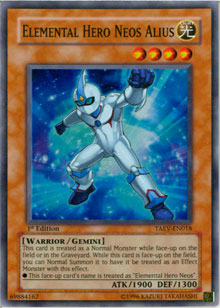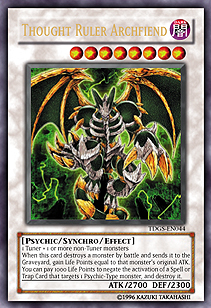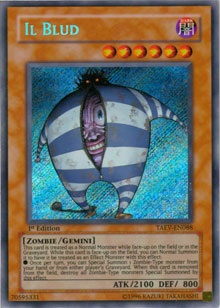Today, we conclude our detailed look at event-specific chains in the damage step. I also wanted to briefly mention special summons that occur in the damage step and the limitations that prevent responses players would normally want to use.
The "Flip Effect" Section
After inflicting battle damage and dealing with any resulting effects, we move on to the next section and deal with a very limited selection of effects. Usually this section of the damage step deals with the flip effect of the monster that was flipped face up by the attack. If the attacked monster has a trigger effect that activates when it is flipped face up (like Royal Keeper), its effect will also be applied here. D.D. Warrior and D.D. Warrior Lady also use this section of the damage step to handle their effects.
 Example 1: Flipped Penguin
Example 1: Flipped Penguin
Player A attacks Player B’s face-down defense position Nightmare Penguin with Elemental Hero Neos Alius. When Nightmare Penguin is flipped face up, its continuous effect of gaining 200 ATK is applied, but its trigger effect isn’t activated until after damage calculation. Damage is calculated and Nightmare Penguin is destroyed. After damage calculation, Nightmare Penguin’s trigger effect activates and starts a chain.
D.D. Warrior is chain link 1 because he is controlled by the turn player, and Gravekeeper’s Spy is chain link 2. When the chain resolves, Gravekeeper’s Spy special summons a "Gravekeeper’s" monster and D.D. Warrior removes himself and Gravekeeper’s Spy from play.
The "Destroyed by Battle Monsters Get Sent to the Graveyard" Chain
The end of the damage step has an event-specific chain that is often used. This is the time when monsters destroyed by battle are sent to the graveyard. We certainly have an abundance of effects tied into destroying the opponent’s monster in battle or being the monster that is destroyed by battle. Sometimes these effects will specify being sent to the graveyard (like Mystic Tomato or Hydrogeddon), while others that aren’t specific won’t really care (like Apprentice Magician or Blue Thunder T-45).
The effects that can be activated in response are still quite limited, usually to counter traps and cards that share this specific timing (like Hero Signal), or cards that have been given special permissions (like Chthonian Blast).
 Example 1: Nimble Momonga and Thought Ruler Archfiend
Example 1: Nimble Momonga and Thought Ruler Archfiend
Player A attacks Player B’s defense position Nimble Momonga with Thought Ruler Archfiend, destroying it. At the end of the damage step, when Nimble Momonga is sent to the graveyard, the effects of each card activate and form a chain. Each effect is a mandatory trigger effect, so Thought Ruler Archfiend is placed as chain link 1, because it is controlled by the turn player, and Nimble Momonga is chain link 2.
When the chain resolves, Player B gains 1000 life points, then special summons up to two Nimble Momonga cards if that player wants to do so. Next, Player A gains 1000 life points with the effect of Thought Ruler Archfiend.
Example 2: Hydrogeddon meets Sangan
Player A’s Hydrogeddon attacks Player B’s defense position Sangan, destroying it. At the end of the damage step, when Sangan is sent to the graveyard, its effect activates. Hydrogeddon’s effect can also be activated at this time, and Player A decides to do so. The effect of Sangan is placed first on the chain because its trigger effect is mandatory, with the effect of Hydrogeddon placed at chain link 2.
When the chain resolves, Hydrogeddon special summons another copy of itself. Next, Player B resolves the effect of Sangan, adding a monster to his hand.
At the end of the damage step, when Handcuffs Dragon is sent to the graveyard, its effect activates. Player B can chain Michizure at this time. When the chain resolves, Michizure can destroy Gladiator Beast Spartacus. The effect of Handcuffs Dragon resolves next, equipping it onto Cyber Dragon.
At the end of the damage step, Apprentice Magician’s effect activates when he is removed from play. Goyo Guardian’s effect does not activate because the Apprentice Magician was removed from play instead of being sent to the graveyard.
Responding to Special Summons in the Damage Step
 If a monster is special summoned in the damage step, it isn’t possible to activate card effects that respond to the summon, like Bottomless Trap Hole or Torrential Tribute, even if the monster is special summoned at the end of the damage step. You might be at the end of the damage step . . . but it’s still the damage step. This isn’t the same as the "end of the battle phase," which we see on the Gladiator Beasts. They use their effects in what is known as the End Step, and it doesn’t have the strict restrictions of the damage step. That’s why you can "Bottomless" your opponent’s "tagged-in" Gladiator Beast Bestiari, but you can’t "Bottomless" that Il Blud he or she special summoned when you destroyed that player’s Pyramid Turtle in battle.
If a monster is special summoned in the damage step, it isn’t possible to activate card effects that respond to the summon, like Bottomless Trap Hole or Torrential Tribute, even if the monster is special summoned at the end of the damage step. You might be at the end of the damage step . . . but it’s still the damage step. This isn’t the same as the "end of the battle phase," which we see on the Gladiator Beasts. They use their effects in what is known as the End Step, and it doesn’t have the strict restrictions of the damage step. That’s why you can "Bottomless" your opponent’s "tagged-in" Gladiator Beast Bestiari, but you can’t "Bottomless" that Il Blud he or she special summoned when you destroyed that player’s Pyramid Turtle in battle.
Most cards normally used to negate summons aren’t of any help in the damage step. The damage step isn’t known for "inherent" special summons, so cards like Black Horn of Heaven and Solemn Judgment are of no use against the many monster effect-based special summons common in the damage step. Yes, Solemn Judgment will help if a spell or trap card is responsible, but it is quite uncommon for this to occur outside of very specific decks. (When’s the last time you saw a player with Destiny Heroes use Destiny Signal?) Royal Oppression can’t even be activated in the damage step, so it’s of no use here. Stopping special summons in the damage step tends to fall into the territory of negating monster card effects, if it happens at all.
Next week: More event-specific chains. Until then, send all comments and questions to Curtis@Metagame.com.
—Curtis Schultz